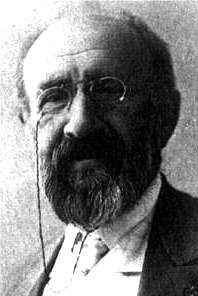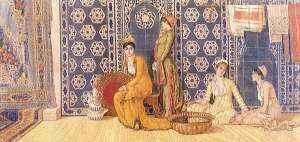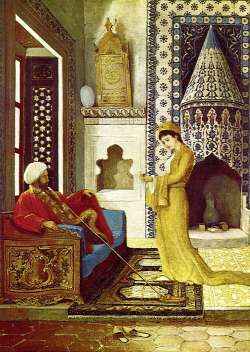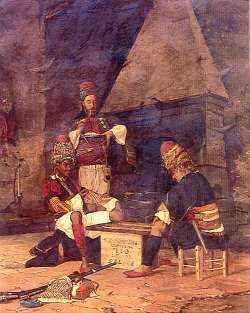Museologist and Painter
OSMAN HAMDİ BEY
 Osman Hamdi Bey (1842-1910) was a distinguished Turkish intellectual. As well
as being a famous painter and a successful archeologist, he was recognized for his
services as a museologist. All his life he was very creative and productive. He was the
founder of the School of Fine Arts (Sanayi-i Nefise Mektebi) as well as being the
first man in Turkey to prepare the law of Conservation of Antiquities. Osman
Hamdi Bey was recently commemorated on the 77th year of his death and he will always be
remembered with esteem. Osman Hamdi Bey (1842-1910) was a distinguished Turkish intellectual. As well
as being a famous painter and a successful archeologist, he was recognized for his
services as a museologist. All his life he was very creative and productive. He was the
founder of the School of Fine Arts (Sanayi-i Nefise Mektebi) as well as being the
first man in Turkey to prepare the law of Conservation of Antiquities. Osman
Hamdi Bey was recently commemorated on the 77th year of his death and he will always be
remembered with esteem.
In brief he was an intellectual who looked forward to the future. His
cultural and artistic activities and endeavors were to lead the society towards
modernization.
The special interest with which he directed himself all through his
life, were based on the education that he received. Osman Hamdi Bey was one of the
privileged persons who had the chance of an education in Europe during a period when very
few people could speak a foreign language, let alone travel in Europe. He lived in Paris
for twelve years and had perfect command of the French language. Initially he was sent to
France to study law but Hs great talent and tendency towards art forced him to dedicate
himself to painting. He had the chance to study with masters like Jean-Léon
and Boulanger. He returned to his country as an artist instead of as a
member of the Bar.
Osman Hamdi Bev's father, İbrahim Edhem Bey was one
of the four Turkish students who were educated in Europe. He had studied Geology and
returned to Turkey as a mining engineer. He had several appointments as an ambassador and
minister and for sometime as the Prime Minister. And Osman Hamdi Bey was introduced to the
western culture in his father's home.
 On his return from Paris in 1869, he went to Baghdad to work
with Midhat Paşa who was the newly appointed Governor of the city. This
was Osman Hamdi Bey's first official appointment and lasted till 1871. When he returned to
Istanbul, he was appointed to the Ministry of Foreign Affairs as Assistant Director of
Protocol. In 1873 he participated at the Vienna exhibition as the representative of the
Ottoman State. In 1877 he was assigned the Directorship of the Istanbul 6th Municipal
Office in Beyoğlu district which lasted for one and a half year. That was his last
official appointment after which he decided to devote his whole time to painting. On his return from Paris in 1869, he went to Baghdad to work
with Midhat Paşa who was the newly appointed Governor of the city. This
was Osman Hamdi Bey's first official appointment and lasted till 1871. When he returned to
Istanbul, he was appointed to the Ministry of Foreign Affairs as Assistant Director of
Protocol. In 1873 he participated at the Vienna exhibition as the representative of the
Ottoman State. In 1877 he was assigned the Directorship of the Istanbul 6th Municipal
Office in Beyoğlu district which lasted for one and a half year. That was his last
official appointment after which he decided to devote his whole time to painting.
 In 4 September 1881, Osman Hamdi Bey was appointed as the
Director of the Archeological Museum. This was the turning point of his life and he began
to work with great energy and accumulation which was very different from his previous
efforts. At this time, though the museum had been established for the last thirty years it
was very poor as far as material was concerned. In general the museum looked like an
antique warehouse. Osman Hamdi Bey restored the museum which was a magnificent building,
employed qualified staff and enriched its collection remarkably. In 4 September 1881, Osman Hamdi Bey was appointed as the
Director of the Archeological Museum. This was the turning point of his life and he began
to work with great energy and accumulation which was very different from his previous
efforts. At this time, though the museum had been established for the last thirty years it
was very poor as far as material was concerned. In general the museum looked like an
antique warehouse. Osman Hamdi Bey restored the museum which was a magnificent building,
employed qualified staff and enriched its collection remarkably.
After a short while, being the museum Director he started leading some
archeological excavations. The excavations in Sidon in 1887 brought to light the group of
sarcophagi, including the Alexander Sarkophagus, the
Sarkophagus of the mourning Women and the Lycian Sarkophagus, which are the chief exhibits
of the Archaeology Museum of Istanbul. Furthermore there are as famous archaeological
places as Nemrut Mountain and Lagina, which increased his
reputation. As a result of his practical experiences archeology became Osman Hamdi Bey's
second profession. In addition to the directorship of the museum, he accepted the offer of
becoming the director of the School of Fine Arts. In this new post, he first reconstructed
the building, set up his academic team and on 2 March 1883, the School of Fine Arts opened
its doors for the first academic year.
Archeology and museology were new sciences and movements of western
origin. Introduction of new trends and activities and their application in the 19th
century Turkey were very important steps towards modernization.
 In 1884 Osman Hamdi Bey legalized the preservation of
historical, cultural and artistic legacy by the Law of Conservation of Antiquities. This
law which brought general regulations for the security of archeological excavations and
finds, could also be applied for the future necessities. For the first time with the
implementation of this law, the transportation of antiques from the country was forbidden
and they were recognized as State Property. In 1884 Osman Hamdi Bey legalized the preservation of
historical, cultural and artistic legacy by the Law of Conservation of Antiquities. This
law which brought general regulations for the security of archeological excavations and
finds, could also be applied for the future necessities. For the first time with the
implementation of this law, the transportation of antiques from the country was forbidden
and they were recognized as State Property.
There is no doubt that the subjects taught at the School of Fine Arts
are more concrete, tend to direct people much more dynamically towards novelty and
modernization as compared to museology. In a period when modem schools were scarce,
establishment of a school where architecture, painting, sculpture and engraving were
taught is an indication Osman Hamdi Bey's high intellectual level and his foresight.
We must not consider him solely as the founder of the School of Fine
Arts but as the pioneer who led the society towards cultural progress.
Pictures:
- Source:
- Osman Hamdi Bey - Müzeci ve Ressam
Prof. Mustafa Cezar
Türk Kültürüne Hizmet Vakfi
|